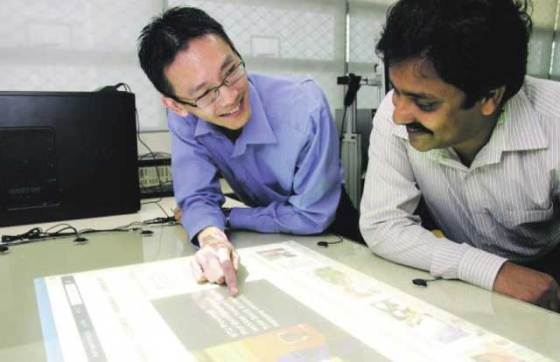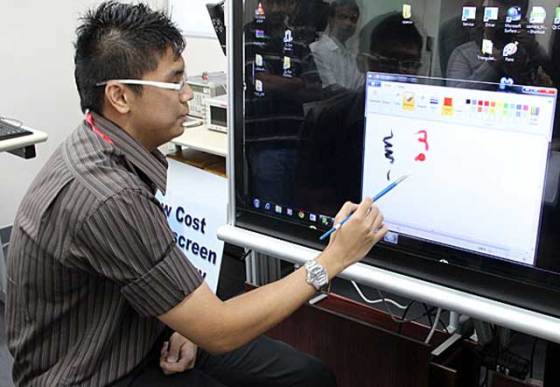STATINA uses vibration to enable information interaction on solid flat surfaces
 We already wrote about various new ways for information interaction, and a group of researchers at the Nanyang Technological University (NTU) developed a low cost system which allows conversion of virtually any flat solid surface around us into a touch sensitive surface. The system relies on the principles of vibration and imaging, and it is able to track the movements of multiple fingers.
We already wrote about various new ways for information interaction, and a group of researchers at the Nanyang Technological University (NTU) developed a low cost system which allows conversion of virtually any flat solid surface around us into a touch sensitive surface. The system relies on the principles of vibration and imaging, and it is able to track the movements of multiple fingers.
“Our innovative system is able to transform surfaces such as wooden tables, aluminum, steel, glass and even plastics into low-cost touch screens. It means in future, you could play computer games or draw sketches on walls or windows since almost all surfaces can be made touch-sensitive with our system”, said Andy Khong, NTU Assistant Professor who led the research.
Named Speech Touch and Acoustic Tangible Interfaces for Next-generation Applications (STATINA), the system relies on principles of vibration waves propagating on a solid surface. Since sound waves propagate through matter at a certain speed, it is possible to derive the location of the touch based on when each sensor picks up the signal. The researchers developed a unique signal processing algorithm to figure out the exact location of the initial point of impact.
By using a few low-cost vibration sensors and the previously mentioned algorithm, the system can pinpoint the location of a light tap on any surface. Combined with a low-cost web-cameras used to track movement, this system can also recognize multiple fingers or objects on any surface.
So far, they have tested their system on surfaces such as wooden tables, aluminum, steel, glass and plastics. NTU researchers are now working to commercialize their invention by developing a more compact system and expanding its capabilities to include tracking of fingers and stylus movements using optical cameras.
Retrofitting the system onto existing flat-panel TVs could transform them into new, touch sensitive display screens, at only a fraction of the cost of new touch-sensitive display screens. It could also be used to create interactive billboards, large mall directories, or even as an interactive whiteboard when combined with a projection system.
For more information, you can read the paper published in IEEE transactions on multimedia: “Localization of taps on solid surfaces for human-computer touch interfaces” [1.5MB PDF].











could u please give me a detailled information about the respective topic, hardware and software required to make this project
Is this the only way to reach you?
author
Better late than never, for us yes. For the team you can go to the page that I just updated since it seems the university changed how their website is organised since this was published.
Hello Sales,
I hope you’re doing well.
I came across a product on your website, Robaid , and I’m interested in purchasing it. Could you please confirm if it’s currently available? Additionally, I would appreciate it if you could send me your product catalog and pricing details.
I’ll be sharing our order list and quantities shortly.
Thank you in advance for your assistance.
Best regards,
McKee Michael